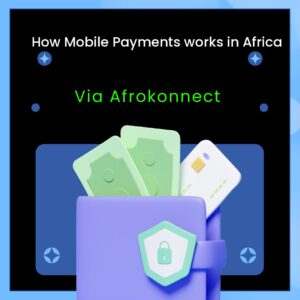Welcome to this post about How Mobile Payments works in Africa, via Afrokonnect. Over the past two decades, Africa has emerged as a global leader in mobile payments, transforming the continent’s financial landscape in ways few could have predicted. In regions where traditional banking infrastructure is limited or inaccessible, mobile payment solutions have enabled millions of people — many for the first time — to send, receive, and store money digitally. Same way digital payment trends in Europe is growing.
What makes the African mobile payments ecosystem so unique is that it did not evolve as an extension of traditional banking, but rather as an alternative to it. In countries where rural communities are widespread and bank branches are scarce, mobile phones have become powerful financial tools.
In this post, we’ll explore how mobile payments work in Africa, the technologies and business models driving them, key players, regulatory frameworks, challenges, and why the rest of the world is paying close attention to Africa’s digital finance revolution.
How Mobile Payments works in Africa
1. The Foundation: Why Mobile Payments Took Root in Africa
To understand the rise of mobile payments in Africa, it’s important to recognize the foundational challenges:
- Low banking penetration: In many African countries, only a fraction of the population had access to traditional banking services.
- Limited infrastructure: Physical bank branches and ATMs are scarce, especially in rural areas.
- High mobile phone usage: Despite low banking access, mobile phone adoption — particularly feature phones — skyrocketed across the continent.
- Cash-based economies: The majority of day-to-day transactions were conducted in cash, creating vulnerabilities and inefficiencies.
The intersection of these factors created the perfect environment for mobile-based financial solutions to flourish — not as a luxury, but as a necessity.
2. What Are Mobile Payments?
Mobile payments in Africa refer to the ability to perform financial transactions using a mobile phone. This includes:
- Sending and receiving money
- Paying for goods and services
- Buying airtime or utilities
- Accessing loans or savings accounts
- Withdrawing cash from agents
These services can be delivered through USSD (Unstructured Supplementary Service Data) for feature phones or mobile apps for smartphones.
Unlike mobile banking in the West — which is typically tied to an existing bank account — many mobile payment services in Africa operate independently of traditional banks, relying instead on mobile network operators (MNOs) and agent networks.
3. The Technology Behind Mobile Payments
There are two primary models through which mobile payments work in Africa:
a) USSD-Based Services
This model uses basic text-based codes that work on any mobile phone, without the need for internet access.
- Users dial a code (e.g., *123#) to access a menu of financial services.
- Transactions are verified with a PIN.
- Funds are stored in a mobile wallet, tied to the user’s phone number.
This model is particularly popular in rural and low-income areas where smartphones and mobile data are less prevalent.
b) Smartphone Applications
With growing smartphone penetration, mobile apps are becoming more common, especially in urban areas.
- Apps allow for richer interfaces, QR code payments, integrations with online merchants, and even biometric security.
- They often connect with digital banks or fintech platforms offering value-added services like microloans or savings products.
4. The Role of Mobile Network Operators (MNOs)
In Africa, mobile network operators play a central role in delivering financial services. Unlike in many parts of the world, where banks lead fintech innovation, African MNOs have been the primary force behind mobile money.
Key Responsibilities of MNOs:
- Provide the technological infrastructure (e.g., USSD gateway, wallet systems)
- Manage customer accounts linked to SIM cards
- Operate or partner with agent networks for cash-in and cash-out services
One of the most iconic examples of this model is M-Pesa in Kenya.
How Mobile Payments works in Africa
5. M-Pesa: The Pioneer of Mobile Money
Launched in 2007 by Safaricom (a subsidiary of Vodafone), M-Pesa is widely regarded as the most successful mobile money service in the world.
How it works:
- Users register for an M-Pesa account linked to their phone number.
- They deposit money into their mobile wallet through agents (often local shops or kiosks).
- Funds can then be sent instantly to another user via SMS or USSD.
- Recipients can withdraw cash at another agent or use the balance to pay bills, shop, or transfer funds.
M-Pesa’s success has inspired similar services across the continent, such as MTN Mobile Money (MoMo), Airtel Money, and Orange Money.
6. Agent Networks: The Human Infrastructure
The scalability of mobile money in Africa is largely dependent on vast agent networks — individuals or small businesses that facilitate:
- Cash-in: Depositing physical cash into a mobile wallet
- Cash-out: Withdrawing money from a wallet as cash
- Account registration and basic customer support
Agents act as the bridge between the digital and physical economy, particularly in regions where formal bank branches are non-existent. Some countries boast hundreds of thousands of agents, more than the total number of ATMs and bank branches combined.
7. Use Cases and Economic Impact
Mobile payments in Africa are not just about convenience — they are transforming entire economies. Key use cases include:
- Peer-to-peer transfers: Workers sending money home to rural families.
- Merchant payments: Paying for groceries or taxi rides with a phone.
- Utility payments: Paying electricity or water bills.
- School fees and salaries: Many institutions now accept digital payments.
- International remittances: Integrated services allow for affordable cross-border transfers.
Economic Impact:
- Financial inclusion: Millions have gained access to financial services for the first time.
- Women’s empowerment: Studies show mobile money helps women control resources and increase their independence.
- Business growth: Small businesses benefit from faster payments and improved cash flow.
- Government efficiency: Some countries use mobile platforms to distribute subsidies or collect taxes.
8. Regulation and Government Support
Regulatory frameworks have played a vital role in the success — and ongoing evolution — of mobile payments in Africa.
- Many central banks adopted a “test and learn” approach, allowing innovation before imposing strict rules.
- Regulatory sandboxes have enabled fintechs to experiment under controlled conditions.
- Recent efforts focus on interoperability, consumer protection, AML/KYC, and data privacy.
Governments are also increasingly embracing mobile money for public services, such as paying social benefits or collecting utility payments.
9. Challenges and Limitations
Despite its many successes, the mobile payments sector in Africa still faces notable challenges:
- Fraud and scams: Social engineering attacks targeting low-literacy users are common.
- Interoperability: In some regions, users cannot easily send money between different mobile money platforms.
- Infrastructure gaps: Poor mobile coverage and power outages can hinder reliability.
- Digital literacy: Many users need more education on how to use mobile financial services safely and effectively.
- Over-reliance on agents: Agent shortages or liquidity problems can cause service disruptions.
Solving these issues will be crucial for the next stage of growth.
10. The Future of Mobile Payments in Africa
Looking forward, mobile payments in Africa are expected to evolve in several directions:
- Smartphone adoption: Continued growth will fuel app-based innovation and richer services.
- Digital credit and savings: Data-driven microloans and savings plans are gaining traction.
- QR code payments: Especially in urban areas, QR codes are becoming a popular method of merchant payment.
- Regional integration: Initiatives like the African Continental Free Trade Area (AfCFTA) may encourage cross-border mobile payment systems.
- Crypto and blockchain: While still early, some fintechs are exploring blockchain for faster, cheaper remittances.
Africa’s mobile payment sector is not just catching up — it’s shaping the global conversation on what financial inclusion and innovation look like in practice. RECOMMENDED: Top 8 Best Online Payment Gateways in Nigeria.
Conclusion about How Mobile Payments works in Africa

Mobile payments in Africa are a striking example of how necessity can drive innovation. In a continent where traditional financial infrastructure failed to reach many, mobile phones have become the foundation of a new, inclusive financial system.
Through a combination of simple technology, adaptable regulation, and human-centered design, Africa has turned mobile payments into a tool for empowerment — connecting families, supporting businesses, and enabling economic participation on a scale once thought impossible.
For the rest of the world, there is much to learn from Africa’s mobile money revolution. It’s a story not just of technology, but of resilience, creativity, and the power of thinking differently.
Thank you for reading this post, on that note, this brings us to the end of this post about How Mobile Payments works in Africa, via Afrokonnect. If this post helped you understand how mobile payments work in Africa, please like, share, or leave your thoughts in the comments below. We’d love to hear your perspective.















